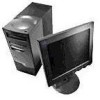IBM 6868 User Guide - Page 71
Low Power Entry Activity Monitor, Automatic Hardware Power Management
 |
UPC - 087944494911
View all IBM 6868 manuals
Add to My Manuals
Save this manual to your list of manuals |
Page 71 highlights
- Standby: In this mode, the screen is blanked, but the screen image is restored immediately when any activity is detected. - Suspend: In this mode, the monitor uses less power than in standby mode. The screen is blanked, but the screen image is restored within a few seconds after any activity is detected. - OFF: In this mode, the monitor power is turned off. To restore power to the monitor, you must press the monitor power switch. On some monitors, you might have to press the power switch twice. If OFF is selected, you must specify the Time to Display 'OFF'. You can select 5 minutes to 1 hour. Note: Time to display off is the amount of time from when the reduced-power state begins until the display turns off. - Disable: In this mode, the monitor is unaffected by the power management settings. IDE Drives: You can use this selection to specify whether the IDE drives are enabled or disabled when power-management features are activated. To set power management features: 1. Start the Configuration/Setup utility program (see "Starting and using the Configuration/Setup Utility program" on page 43). 2. Select Power Management and press Enter. 3. Select APM and press Enter. 4. Set APM BIOS Mode to Enabled or Disabled. 5. Set Automatic Hardware Power Management to Enabled. 6. Select values for power management (time to low power, system power, processor speed, display, and time to display off), as desired. 7. Select Low Power Entry Activity Monitor and press Enter. 8. Set to Enabled or Disabled devices you want to be monitored for power management. Note: If all devices are set to disabled, you must restart the computer to wake the system. 9. Press Esc three times to return to the Configuration/Setup utility program menu. 10. Select Save Settings from the Configuration/Setup utility program menu; then press Esc and follow the instructions on the screen to exit from the Configuration/Setup utility program. Chapter 4. Using the Configuration/Setup Utility program 57















